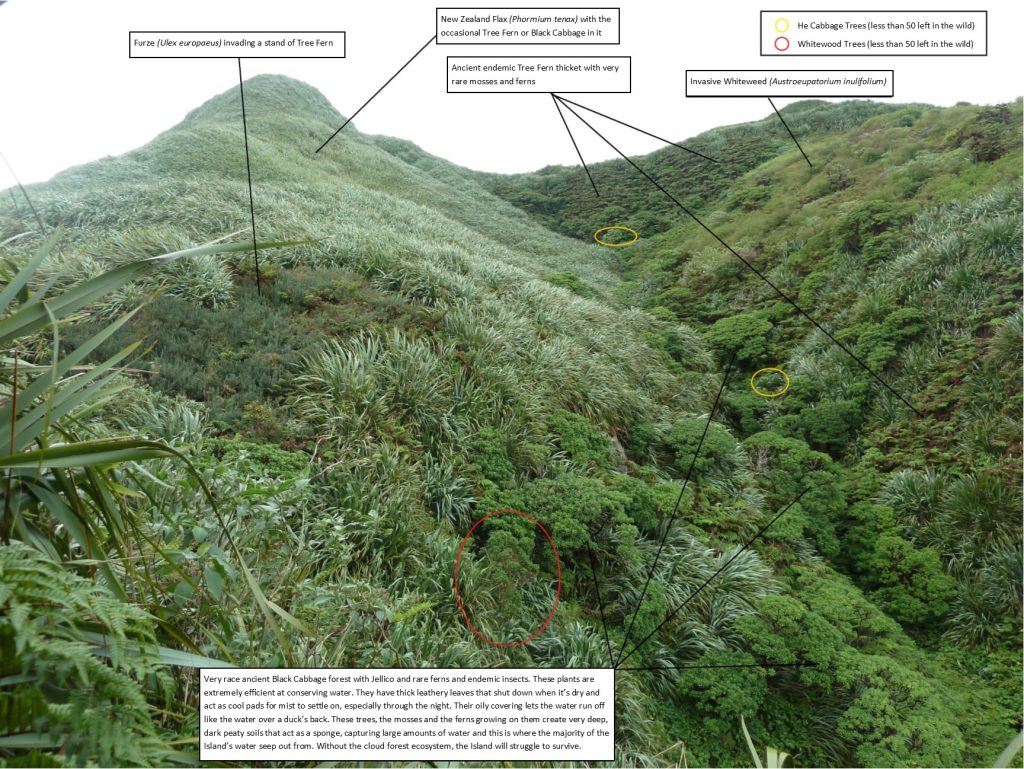24 January 2019
The Terrestrial Conservation Section (TCS) of the Environmental Management Division (EMD) has successfully secured funding for a three-year conservation project, starting in April 2019.
The project – ‘Fragmented cloud forest habitat rehabilitation through innovative invasive plant management’ – valued at £294,309.00 is being funded by Darwin Plus and will expand fragments of important native biodiversity and link these via native vegetation corridors through managing invasive vegetation.
Terrestrial Conservation Officer, Lourens Malan, explains more about the project:
“Most of the endangered areas of the Peaks will be identified and ‘saved’ wherever they hide, like on the near vertical cliffs of High Peak. These small areas are often the most valuable in terms of how many rare endemics they have in them. The small, valuable areas will also be linked up by creating strips of endemic habitat that can serve as a path for our endemic invertebrates like the Spiky Yellow Woodlice to move between.
“We are proud to have this project run locally, alongside the brilliant work done by the Peaks Team. Their continued hard work is now paying off and has received international recognition.”
Nursery Officer, Vanessa Thomas-Williams, added:
“This project is brilliant. We have to save the endemics from going extinct. The work we do will save rare plants and their habitats and also the endemic insects. This project will help us with increasing our resources – putting more hands on the ground where it matters.”
External project partner from the Centre for Ecology & Hydrology (CEH) in the UK, Professor Helen Roy, concluded:
“I had the privilege to spend time with Lourens and his team on St Helena in November 2018 and was extremely impressed by the work that they have been undertaking. The plans outlined within this project are exciting and timely. Additionally, they align with the research interests of the research group I lead at the CEH. There is considerable scope to transfer knowledge from these activities to the UK Overseas Territories.”
Notes to Editors
Invasive species are the biggest biodiversity threat globally and on St Helena. From a total of 431 higher plant species recorded growing in the wild, 370 are non-native. This means 99% of the Island’s vegetation cover is classified as non-native. The remaining area is highly fragmented with some small areas dominated by natives. This small area hold over 30% of the total endemic diversity of the UK and its 14 Overseas Territories and is of significant international importance.
Conserving the remaining 1% of natural habitat is undoubtedly crucial to ensure the survival of the remaining endemic species. This has been corroborated by the currently running ‘Invasive Plant Species Management Project’ (DPLUS059) that identified the rare endemic cloud forest as a key priority area for better targeted invasive plant species control.
Results from the recently completed ‘Securing St Helena’s Rare Cloud Forest Trees And Associated Invertebrates’ (DPLUS029) project ascertained that small habitat fragments hold significant assemblages of rare endemic invertebrates which often are doomed to die out. Any further loss of habitat could have detrimental effects and would likely result in extinction for many of these unique species.
#StHelena #Conservation #InvasiveSpecies #DarwinPlus
https://www.facebook.com/StHelenaGovt/
https://twitter.com/StHelenaGovt
SHG
24 January 2019
